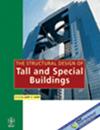Seismic loss optimum design of steel structures using learning‐based charged system search
IF 1.3
3区 工程技术
Q3 CONSTRUCTION & BUILDING TECHNOLOGY
引用次数: 4
Abstract
One of the structural engineers' challenges on a regular basis is balancing the expense of initial construction with the cost of future structural loss. At first appearance, employing the optimization method seems to be a viable option. However, since both the structure's analysis and design, as well as the computation of the cost of future loss, are time‐consuming and expensive, combining these processes with the costly optimization progression is prohibitively expensive. The purpose of this study is to present a methodology for the risk‐based optimum design of steel frame structures, as well as to enhance a previously published metaheuristic algorithm for a better optimization approach. The methodology given here allows structural designers to account for seismic risks in the design optimization process without incurring expensive computing expenditures. This approach may be appealing for practical work since it minimizes time‐consuming charges and provides designers with a structural impression. Furthermore, as compared to the standard version, the new optimization algorithm improves performance while decreasing computing costs. Bayesian linear regression is used in conjunction with a parameter identification challenge to derive probabilistic models for estimating structural analysis demand responses. The minimum amount of total initial cost and seismic loss cost is regarded as the objective function of the design of three chosen mid‐ to high‐rise moment frames for the optimization purpose. The results demonstrated enhanced optimization performance as well as a decreased loss cost for employed structures.基于学习的带电系统搜索法在钢结构地震损失优化设计中的应用
结构工程师经常面临的挑战之一是平衡初始建设的费用和未来结构损失的成本。乍一看,采用优化方法似乎是一个可行的选择。然而,由于结构的分析和设计以及未来损失成本的计算都是耗时且昂贵的,因此将这些过程与昂贵的优化过程结合起来是非常昂贵的。本研究的目的是提出一种基于风险的钢架结构优化设计方法,并改进先前发表的元启发式算法,以获得更好的优化方法。本文给出的方法允许结构设计人员在设计优化过程中考虑地震风险,而不会产生昂贵的计算支出。这种方法可能对实际工作很有吸引力,因为它最大限度地减少了耗时的费用,并为设计师提供了一个结构印象。此外,与标准版本相比,新的优化算法在降低计算成本的同时提高了性能。贝叶斯线性回归与参数识别挑战一起使用,以导出用于估计结构分析需求响应的概率模型。将初始总成本和地震损失成本的最小值作为三个中高层弯矩框架设计的目标函数,以达到优化目的。结果表明,该方法提高了优化性能,降低了所用结构的损失成本。
本文章由计算机程序翻译,如有差异,请以英文原文为准。
求助全文
约1分钟内获得全文
求助全文
来源期刊
CiteScore
5.30
自引率
4.20%
发文量
83
审稿时长
6-12 weeks
期刊介绍:
The Structural Design of Tall and Special Buildings provides structural engineers and contractors with a detailed written presentation of innovative structural engineering and construction practices for tall and special buildings. It also presents applied research on new materials or analysis methods that can directly benefit structural engineers involved in the design of tall and special buildings. The editor''s policy is to maintain a reasonable balance between papers from design engineers and from research workers so that the Journal will be useful to both groups. The problems in this field and their solutions are international in character and require a knowledge of several traditional disciplines and the Journal will reflect this.
The main subject of the Journal is the structural design and construction of tall and special buildings. The basic definition of a tall building, in the context of the Journal audience, is a structure that is equal to or greater than 50 meters (165 feet) in height, or 14 stories or greater. A special building is one with unique architectural or structural characteristics.
However, manuscripts dealing with chimneys, water towers, silos, cooling towers, and pools will generally not be considered for review. The journal will present papers on new innovative structural systems, materials and methods of analysis.

 求助内容:
求助内容: 应助结果提醒方式:
应助结果提醒方式:


